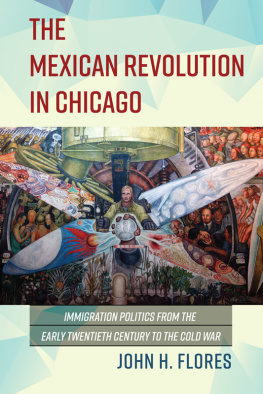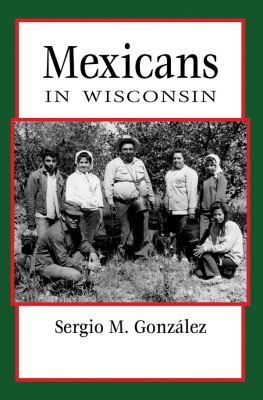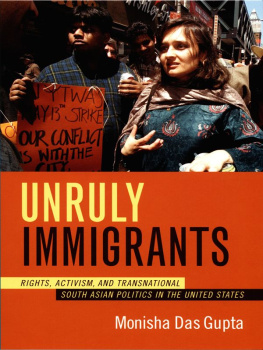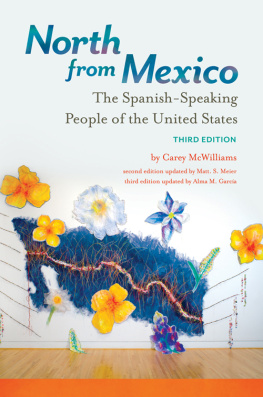The Mexican Revolution in Chicago
LATINOS IN CHICAGO AND THE MIDWEST
Series Editors
Frances R. Aparicio, Northwestern University
Juan Mora-Torres, DePaul University
Mara de los Angeles Torres, University of Illinois at Chicago
A list of books in the series appears at the end of this book.
The Mexican Revolution
in Chicago
Immigration Politics from the Early
Twentieth Century to the Cold War
JOHN H. FLORES
The companion website is located at
https://www.press.uillinois.edu/books/flores/mexican_revolution_in_chicago
2018 by the Board of Trustees
of the University of Illinois
All rights reserved
Cataloging-in-Publication Data available from the
Library of Congress
ISBN 978-0-252-04180-8 (cloth: alk.)
ISBN 978-0-252-08342-6 (paper: alk)
ISBN 978-0-252-05047-3 (ebook)
Cover illustration: Diego Rivera, Man, Controller of the Universe 2017 Banco de Mxico Diego Rivera Frida Kahlo Museums Trust, Mexico, D.F. / Artists Rights Society (ARS), New York.
This book is dedicated to my father, a Mexican
immigrant who taught me to work; to my mother,
a Mexican immigrant who taught me to study;
and to my brothers, who taught me to share.
Contents
Acknowledgments
I could not have written this book without the support of a community of scholars, friends, and family members. My community read chapters of this book, recommended ways to improve them, pointed me toward specific sources, and, at times, reminded me of the values that led me into this profession in the first place.
As a graduate student in the History of Work, Race, and Gender in the Urban World program at the University of Illinois at Chicago (UIC), I was privileged to have been advised by Leon Fink, the director of the program. Leon mentored me throughout my graduate education. He shared his expertise and experiences with me, always assessed my work thoroughly, and always offered me critical and valuable advice. Eric Arnesen also mentored me at UIC. Eric provided me with extremely helpful and caring guidance at pivotal moments during my graduate education. I cannot thank him enough for his commitment to me and my future. Juan Mora Torres at DePaul University took an interest in my research early on and expanded my professional network in Chicago, providing me with opportunities to share my findings with the public. Juan, along with Susan Levine and Perry Duis, worked closely with me to refine my early research, which served as the starting point for this book. I thank them all for their help, patience, and key recommendations.
In its current form, this book came into being through the support and encouragement of the Department of History, the Social Justice Institute (SJI), and the College of Arts and Sciences at Case Western Reserve University (CWRU). My colleague in the Department of History and the director of the Social Justice Institute, Rhonda Williams, helped place me in the position to contribute to the field of immigration history and to the development of the department and the institute. I am incredibly fortunate to work with Rhonda and the faculty and staff of an institute that reflects my core values and consistently demonstrates that another world is necessary and possible.
Within the Department of History, David Hammack has served as my faculty mentor, and he has been invaluable to me. I have benefited tremendously from Davids vast experience, his keen recommendations, and his consistent encouragement. I am fortunate to have been mentored by David Hammack. Ken Ledford and Jonathan Sadowsky have also served as my de facto advisors, providing me with guidance and fellowship over the course of many years. Ken is truly exceptional in his support of junior faculty members, and I routinely drew on him for advice and assistance. All the while, Ted Steinberg has been a true friend. Working at any university can be challenging, but caring and genuine people like Ted remind you that you are not alone. Outside the department, Marilyn Mobley has been a strong advocate of my work and a kind friend. I always felt empowered after talking to Maril, and for that, I thank her tremendously. More recently, Ananya Dasgupta and Tim Black have bolstered my morale as I labored away on the final aspects of this manuscript. They are insightful and wonderful people, and I thank them for their friendship and encouragement.
Notably, the research for this book could not have been completed without the vital support of Dean Cyrus Taylor of the College of Arts and Sciences and Provost William Baeslack. Soon after I began my appointment, I was awarded the Climo Junior Chair, which provided me with resources to expand the research for this book. Through this research, I was able to create a census of Hispanic naturalization in Chicago, which distinguishes my work from other projects on Mexican Chicago in a number of fundamental ways. Working with several graduate students, including Nathan Delaney, Elizabeth Salem, John Baden, Corey Hazlett, Eric Miller, and Ryan Chamberlain, I was able to organize and aggregate data from more than three thousand naturalization records. Nathan Delaney, in particular, was instrumental in the data collection and in the creation of the historical maps of Latino Chicago that appear in the companion website to this book. Elizabeth Salem, meanwhile, helped me track down numerous sources and worked with me on managing various aspects of the project. I thank all of these graduate students for their assistance.
The immigration records I worked with were collected through the considerable work of many archivists and administrators. In particular, Martin Tuohy and the staff at the National Archives and Records Administration worked patiently with me as they retrieved tens of thousands of naturalization documents for my use. In this same vein, Licenciado Alejandro Rivera and the staff at the Archivo Histrico de la Secretaria de Relaciones Exteriores in Mexico City worked closely with me to access records that reshaped my understanding of the transnational activism of Mexican immigrants. Licenciado Rivera is a true gentleman. He not only expedited my research at the archive but also offered me his friendship and taught me much about his incredible city.
As the book took form, I was delighted to learn that it would be published by the University of Illinois Press and, in particular, within a series on the Midwest and Chicago, the city of my birth, which will always hold a special place in my heart. At the University of Illinois Press, I would especially like to thank Francis R. Aparicio for her commitment to the project. I cannot thank her enough. I would also like to thank my patient editor, Dawn M. Durante, whose enthusiasm has been incredibly encouraging. Finally, I wish to express my sincerest appreciation to the copyeditor, Mary M. Hill, and to the two anonymous outside readers who helped me produce a better book.
There are many wonderful people who also helped make this book possible in direct and indirect ways. Among those whom I wish to thank for their advice, assistance, and friendship are Jos Angel Hernndez; Lorrell Kilpatrick; Sam Mitrani; Joseph Lipari; John Rosen; Juanita Del Toro; Sarah Koning; Marc Rodriguez; Josh Fennell; Dan Harper; Jaime Pensado; Cat Jacquet; Theresa Christensen-Caballero; Lunaire Ford; Jos Perales; Francisco Pia; Kathy Tobin; James Lane; Alan Spector; Gene Defelice; Victor Holden; Lupe Ramirez and Jaime Salazar; Agustina, Enrique, and Sylvia Lizcano; Mat Chico; and Martha, Juan, Steven, Bryan, Logan, Bianca, and Nana Flores. I thank each of you for your unique contributions.








